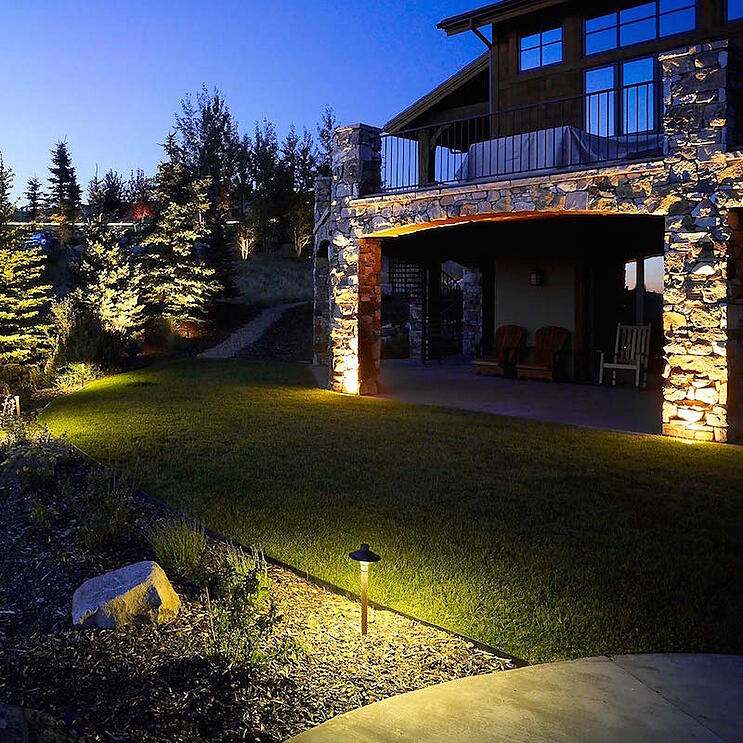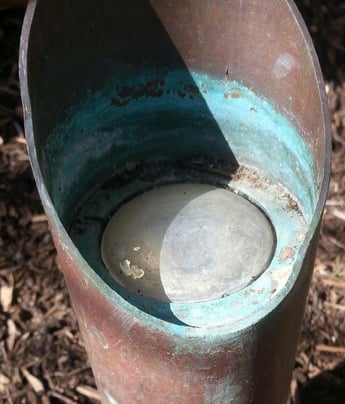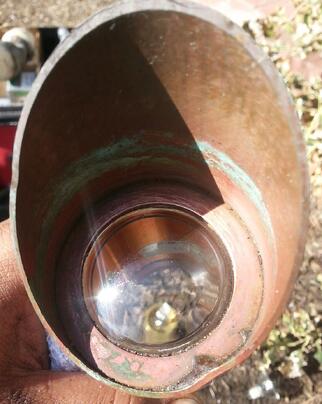5 Ways to Ensure Your Outdoor Lighting System Will Fail
This might sound strange, but installing a low voltage outdoor lighting system isn’t, by any means, a matter of simply shoving lights in the ground. It requires forethought, quality materials, experience, and a solid plan to create a beautiful lighting system. While there are plenty of ways to guarantee a lighting system will fail, here are our top five ways to ensure it could happen to your system if you don’t plan ahead.

1. Placing fixtures in the wrong locations.
There are certain aspects of your fixture placement that must be taken into consideration before installing your fixtures. To ensure long lasting enjoyment, fixtures need to be placed in such a way that they will not become needlessly damaged. For example, it’s not recommended that path lights (or any other light for that matter) be placed in a turfed area. Lawn mowers, weed whackers, etc., will more than likely come in contact with your path light and damage it if it is put in harms way.
Another example is placing a path light along a drive way where it might be hit by a car door, or be knocked down by annual snow removal. Installing fixtures in the wrong place can lead to adverse consequences. While the placement may conceptually make sense, it’s important to step back and consider the problems that fixture might have down the road.
2. Not consulting with a professional could lead to a failed system.
With the undertaking of any project, it’s always important to do your research. It is imperative that you have a thorough understanding of what you are getting yourself into.
Consulting with your outdoor lighting specialist isn’t just a good idea, it’s a grand idea. Meeting with someone who knows what they are doing will help you better understand why things should be done a certain way. They will be able to answer questions and bring their years of expertise to the table. But most importantly, they will know how to apply lighting in a way that you would have never understood or come up with on your own. They might discuss core lighting, or bistro lighting, or other approaches to lighting that might not have occurred to you. Bringing a professional on site will help you see lighting in a whole new, well, light.
3. Using poorly constructed fixtures.
Using a poorly crafted fixture will cause you nothing but headaches down the road. While there is a myriad of different lighting fixtures on the market, there are only a select number that can really take a beating. By beating, I simply mean that only certain fixtures are up to the challenge of lasting a lifetime. These fixtures are the ones that haven’t allowed their materials or engineering to be compromised by cheap parts or flimsy components. For example, a solid copper or brass fixture will last decades beyond the pitiful 1-5 year lifespan of an aluminum or plastic one.
Crafting a fixture out of copper or brass, however, isn’t a guarantee of its success. You also have to consider how it has been engineered. A solid fixture has to be capable of withstanding contact with moisture and temperature fluctuations. A solid fixture needs to be water tight. If water can easily get into the socket and lamp, it will lead to all sorts of problems down the road. The point of putting a lighting system in your property should be to have a system you can enjoy for years to come. If you are going to have to keep replacing cheaply made fixtures down the road, why bother?
There is one other thing that should be briefly mentioned here. Even having the best fixtures in the world can still lead to a failed lighting system if the application is wrong. The lighting design itself is a key component of a systems success.

4. Poor Engineering.
One of the key components to a successful lighting system is how everything is tied together. If this isn’t done right, then everything will fall apart. The 12 gauge wire you use, for example, needs to be buried a minimum of 6-8″. The deeper your wire, the less chance there is for something to come along and damage it. Besides, who wants to see all the wire? Your wire is what powers everything and keeps it all working. It needs to be hidden and placed out of harms way.
Its not just the wire you need to worry about. You also need to be concerned about how effective your wire connections will be in the long run. It’s important that your wire connections serve more than just their one obvious function: connecting power to the fixture. Your wire connections must be able to keep your wire insulated ad protected from water. If water gets into your wire connections, it can lead to shorts, or other problems, that will trip your system. Greased wire nuts won’t cut it. Even if they are taped, wire nuts are still susceptible to moisture in the ground. Wire nuts are meant to be used in your home, not in your landscape. Using watertight connections is paramount to the success and longevity of your overall system.
You can forget about how wonderful your fixtures and LED lamps are if they are destined to lose power and have wiring issues.
5. Finally, the best way to ensure that your outdoor lighting system will fail is not servicing it.
A lighting system needs to be looked after. It will need routine maintenance done on it down the road to ensure that it will continue to work at peak performance.
As strange as it might sound, the ground in our yards will move. With an average of over 200 freeze and thaw cycles in Utah each year, and the continued growth of your trees and plants, your fixtures will be slowly lifted out of the ground. This means that your fixtures will, over time, begin to look crooked, they will start aiming in directions you don’t want them to. Also, hard water will begin to build up on your lenses. This will need to be vigorously scrubbed off so that the light source doesn’t become obstructed. Vegetation also needs to be trimmed back when it begins to grow over your fixtures for the same reason. The best reason for servicing your system though, is simply to check up on everything and fix things before they become a problem.
A lighting system is a lot like a dependable car. While you don’t really need to worry yourself about it breaking down, you still put in the TLC it needs to ensure that it will keep running at its best.


Give us a Call:
To learn more about how to light your outdoor living space, call us at (801) 440-7647 to schedule a free consultation, or feel free to simply fill out a contact form.
Located in Midvale, Landscape Lighting Pro of Utah serves throughout Utah’s residential areas, including Salt Lake City, Park City, Draper, Davis and Utah Counties. Our outdoor lighting portfolio includes projects throughout Utah and beyond.
Salt Lake City (Midvale)
801-440-7647
St. George
435-932-6627
©2025 Landscape Lighting Pro
Privacy Policy
Cookie Policy